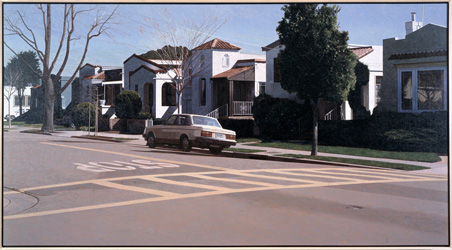Robert Bechtle, Six Houses on Mound Street, 2006.
Born 1932 in San Francisco, California; lives in San Francisco, California
For the last forty years, Robert Bechtle has painted portraits, genre scenes, and landscapes as notable for their willfully prosaic leisureclass iconography—replete with suburban bungalows, manicured lawns, patios, and, most frequently, cars—as for their technical facility. As the apocryphal story goes, having returned from a trip to Europe in 1962, Bechtle drove cross-country from New York; near to home, he noticed an overpass dotted with palm trees. “All of a sudden, this stuff that I’d grown up with in California, but hadn’t paid much attention to as having anything to do with art,” Bechtle later recalled in an interview for SFGate.com, “came into focus.” This last turn of phrase is apt since Bechtle has long used 35-millimeter color slides projected onto his supports as the basis of his images, which he then develops through layers of underdrawings and washes. (Indeed, initially exhibiting his works alongside those of Richard Estes, Philip Pearlstein, and Alex Katz, he is often considered the first Photorealist.)
Bechtle’s early works mined autobiography and locality, as in the iconic ’61 Pontiac (1968–69), an oil painting of the artist and his young family with their station wagon; Fosters Freeze, Alameda (1970) captures his first wife and children eating ice cream in an all-too familiar suburban scene. Quotidian mainstays—and their uncanny, desolate placidity—persist in recent work. Cars are still omnipresent if often shrouded: the small watercolor Covered Car—High Street (2004) gives over the entirety of its frame to its titular focus. Likewise consistent is Bechtle’s interest in figuration, although his latest series of self-portraits (2004–06) reveals an unprecedented sobriety of the aging subject facing mortality.
One could suggest that however representational Bechtle’s compositions are, his subject is the mediation of vision and even light itself: how it bounces off a chrome bumper, is flattened in a midday blaze, seeps into rooms, or radiates from an incandescent source. Edward Hopper once described his enigmatic Second Story Sunlight (1960) as “an attempt to paint sunlight as white with almost no . . . yellow pigment in the white. Any psychological idea will have to be supplied by the viewer.” In this tradition, Bechtle’s paintings produce an anticipatory stillness, a fact made only more poignant as they become harbingers of something more tangible—an apparition seen as though for the first and last time. SUZANNE HUDSON
Robert Bechtle, Six Houses on Mound Street, 2006. Oil on canvas, 36 x 66 in. (91.4 x 167.6 cm). Private collection
























